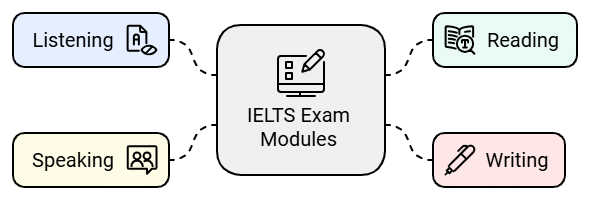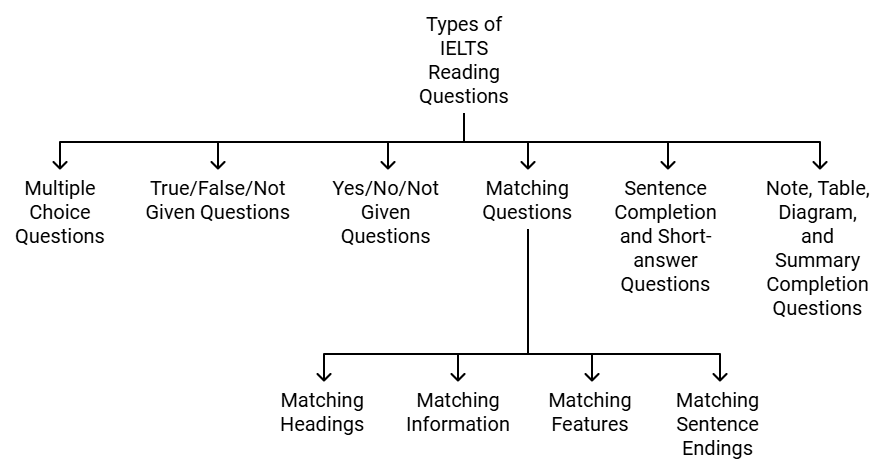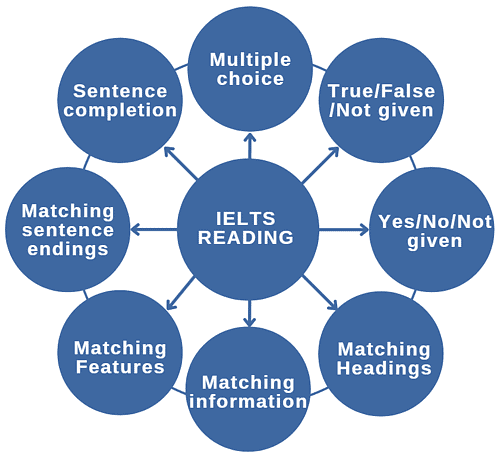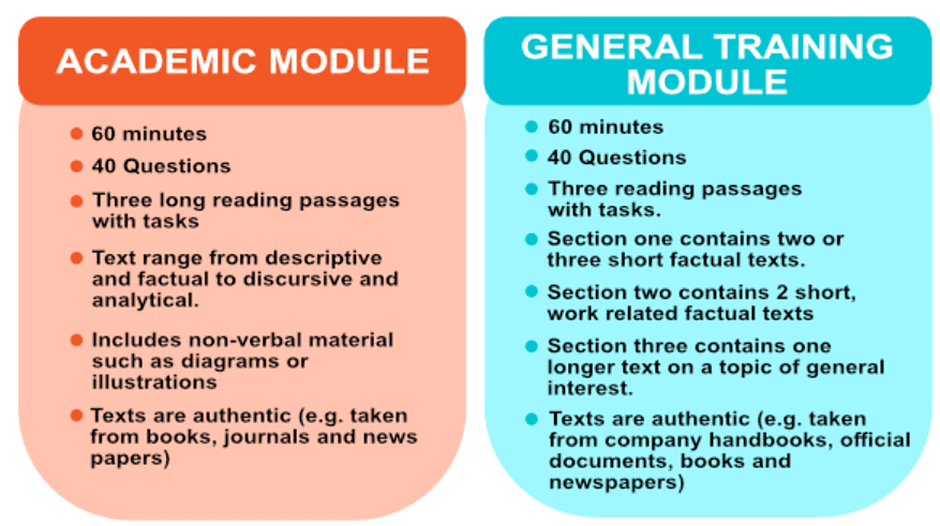Reading Module for IELTS: Exam Pattern & Scoring | Reading for Academic IELTS PDF Download
| Table of contents |

|
| Reading Module Pattern |

|
| Academic Reading |

|
| General Training Reading |

|
| Highlights of Academic and General Training Reading Module |

|
Before getting into the specifics of the IELTS exam, it is crucial to understand that there are four sub-sections that each examine a different aspect of your language proficiency. Don't forget that mastery of all of these courses is required if you want to describe yourself as an expert user of the English language.
What are the sub-sections?

The sub-sections of the IELTS exam are rendered as the modules of IELTS. There are simply 4 modules, namely:
- Listening
- Reading
- Writing
- Speaking
Reading Module Pattern
1. Total time: 60 minutes
2. Passages: 3 (20 min on each suggested)
The Reading section consists of 40 questions, designed to test a wide range of reading skills. These include reading for gist, reading for main ideas, reading for detail, skimming, understanding logical argument and recognizing writers' opinions, attitudes and purpose.
3. There are two types of levels of reading offered by IELTS:
- Academic Reading (for students)
- General Training Reading (for job applicants)
EduRev has compiled a detailed course for your IELTS Academic Reading practice. Check it out here.
Academic Reading
This includes three long texts which range from descriptive and factual to discursive and analytical.
Paper format
- Three reading passages with a variety of questions using a number of task types.
Task types
- A variety of question types are used, chosen from the following; multiple choice, identifying information, identifying the writer’s views/claims, matching information, matching headings, matching features, matching sentence endings, sentence completion, summary completion, note completion, table completion, flow-chart completion, diagram label completion and short-answer questions.
Sources
- Texts are taken from books, journals, magazines and newspapers, and have been written for a non-specialist audience. All the topics are of general interest. They deal with issues which are interesting, recognizably appropriate and accessible to test takers entering undergraduate or postgraduate courses or seeking professional registration.
- The passages may be written in a variety of styles, for example, narrative, descriptive or discursive/argumentative. At least one text contains a detailed logical argument. Texts may contain non-verbal materials such as diagrams, graphs or illustrations. If texts contain technical terms a simple glossary is provided.
Answering
- You are required to transfer your answers to an answer sheet during the time allowed for the test. Remember, unlike the listening test, you will be given. No extra time to transfer your answers to the reading answer sheet.
- Also, care should be taken when writing answers on the answer sheet as poor spelling and grammar are penalized.
Marks
- Each question is worth 1 mark.
Question types
Just like listening, Academic Reading has a set of question types that you have to attempt in a similar pattern of listening.

The different types of questions are mentioned below:
1. Multiple Choice Questions: IELTS reading multiple choice questions have about 3-4 options from which you have to choose your answer. This might be in the form of a question & answer type or a choose a correct ending to a sentence type.
2. True/False/Not given Questions: These questions are very tricky. This question consists of several statements:
- If the statement is present in the article as it is then you need to mark it as true.
- If the statement is found to be the opposite of the sentence which is there then it should be marked as false.
- If the statement given in the question is not at all present in the article then it should be marked as not given. Do not spend a lot of time finding the sentence which is not there.
3. Yes/No/Not given Questions: Similar to the True/False/Not given questions, Yes/No/Not given questions also have various statements. But here you are asked to agree or disagree with the statement based on the opinion of the author.
4. Matching Questions: There are various types of matching questions in IELTS reading tests and each one is different from another.
(a) Matching Headings: In this type of question, a list of headings will be given and you are asked to match these headings with a paragraph in the passage. You should read the headings before you begin reading the text. To get the correct answer, you have to read the complete paragraph and not just stop with the first few lines of the paragraph. There will also be many other headings that are not related to any of the paragraphs given in the passage, in such cases, try to identify those types of headings too.
(b) Matching information: Matching Information questions have a list which contains information taken from the paragraphs. You are asked to find out the paragraph from which the information is taken. Sometimes the question may be tricky because the information given might not be in exact words as given in the paragraph instead it will be paraphrased so you need to read the paragraph to understand the meaning/idea behind it to answer these questions.
(c) Matching Features: In this type of question, there will be a list of items in the box and you need to match these items by reading and understanding some sentences in the passages. The list may be of the name of people or cities. For example, If there is a name of a person in the box of items then the question may be to match the sentence with the person who said them. Like other types of match questions, some of the items mentioned may not be available in the passage. So, to save time read the passage before answering each question.
(d) Matching sentence endings: In this type of question, you need to connect two halves of the sentences. The first half of the sentence will be already given you need to find out which is the appropriate ending for the sentence from the list given. While choosing from the list you need to keep the following things in mind:
- There should not be any grammatical errors in the sentence.
- The ending sentence chosen by you should make sense
- The sentence should have the same meaning as the sentence in the passage.
5. Sentence completion and Short-answer Questions
IELTS Reading Sentence completion and Short answer questions are almost similar. In sentence completion, you’ll be asked to fill in the blank spaces using the words given in the text. Whereas, in short answers, you’ll have to take words from the given text to write the short answers. It is important to pay close attention to the instructions that are given in the question because in some instructions there will be a word limit mentioned and you may lose marks if you don’t follow it.
6. Note, Table, Diagram and Summary Completion Questions
In Note, Table, Summary and Diagram completion questions, you will be asked to complete a set of notes, tables, diagrams or a summary based on the information given in the text. Sometimes the question will be to write a short answer and sometimes you’ll have to choose from the list of answers given. Usually, these kinds of questions will only be based on one part of the passage, so you won’t have to read the whole passage to fill in the important information.
General Training Reading
If you are looking for a job and you attempt the General Training test then you might be under a little less pressure. GT Reading is a little less complicated than Academic Reading.
You should want to pick up some extracts from books, magazines, newspapers, notices, advertisements, company handbooks and guidelines, that will help you practice for the test. These are materials you are likely to encounter on a daily basis in an English-speaking environment.
EduRev has compiled a detailed course for your IELTS General Training Reading practice. Check it out here.
Paper format
- There are three sections. Section 1 may contain two or three short texts or several shorter texts. Section 2 comprises two texts. In Section 3, there is one long text.
Timing
- The time given for reading section is 60 minutes.
No. of questions
- Total number of questions is 40.
Task types
- A variety of question types are used, chosen from the following: multiple choice, identifying information, identifying writer’s views/claims, matching information, matching headings, matching features, matching sentence endings, sentence completion, summary completion, note completion, table completion, flow-chart completion, diagram label completion, short-answer questions.
Sources
- The first section, ‘social survival’, contains texts relevant to basic linguistic survival in English with tasks mainly about retrieving and providing general factual information, for example, notices, advertisements and timetables.
- The second section, ‘Workplace survival’, focuses on the workplace context, for example, job descriptions, contracts and staff development and training materials.
- The third section, ‘general reading’, involves reading more extended prose with a more complex structure. Here, the emphasis is on descriptive and instructive rather than argumentative texts, in a general context relevant to the wide range of test takers involved, for example, newspapers, magazines and fictional and non-fictional book extracts.
Answering
- You are required to transfer your answers to an answer sheet during the time allowed for the test. No extra time is allowed for transfer. Care should be taken when writing answers on the answer sheet as poor spelling and grammar are penalized.
Marks
- Each question is worth 1 mark.
Question types
- Just like Academic Reading, General Training Reading has a similar set of question types that you have to attempt in a similar pattern.

Highlights of Academic and General Training Reading Module

|
27 videos|77 docs
|
FAQs on Reading Module for IELTS: Exam Pattern & Scoring - Reading for Academic IELTS
| 1. What is the structure of the IELTS Reading Module for both Academic and General Training? |  |
| 2. How is the IELTS Reading Module scored? |  |
| 3. What types of questions can I expect in the IELTS Reading Module? |  |
| 4. How long is the IELTS Reading Module, and what is the time allocation for each section? |  |
| 5. Can I take notes or highlight text during the IELTS Reading Module? |  |





















